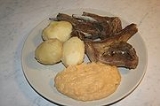
Pinnekjøtt
Encyclopedia

Norway
Norway , officially the Kingdom of Norway, is a Nordic unitary constitutional monarchy whose territory comprises the western portion of the Scandinavian Peninsula, Jan Mayen, and the Arctic archipelago of Svalbard and Bouvet Island. Norway has a total area of and a population of about 4.9 million...
, Pinnekjøtt is a main course dinner dish of lamb or mutton. Pinnekjøtt is a festive dish typical to Western- and Northern Norway, served with purée
Purée
Purée and mash are general terms for cooked food, usually vegetables or legumes, that have been ground, pressed, blended, and/or sieved to the consistency of a soft creamy paste or thick liquid. Purées of specific foods are often known by specific names, e.g., mashed potatoes or apple sauce...
d rutabaga
Rutabaga
The rutabaga, swede , turnip or yellow turnip is a root vegetable that originated as a cross between the cabbage and the turnip; see Triangle of U...
and potato
Potato
The potato is a starchy, tuberous crop from the perennial Solanum tuberosum of the Solanaceae family . The word potato may refer to the plant itself as well as the edible tuber. In the region of the Andes, there are some other closely related cultivated potato species...
es, beer and akevitt
Akvavit
Akvavit or aquavit is a traditional flavoured spirit that is principally produced in Scandinavia, where it has been produced since the 15th century....
. This dish is largely associated with the celebration of Christmas, and is rapidly gaining popularity in other regions as well. 31 % of Norwegians say they eat pinnekjøtt for their family Christmas dinner.
Preparation
The preparation of pinnekjøtt uses a traditional method for food preservationFood preservation
Food preservation is the process of treating and handling food to stop or slow down spoilage and thus allow for longer storage....
utilizing curing
Curing (food preservation)
Curing refers to various food preservation and flavoring processes, especially of meat or fish, by the addition of a combination of salt, nitrates, nitrite or sugar. Many curing processes also involve smoking, the process of flavoring, or cooking...
, drying
Drying (food)
Drying is a method of food preservation that works by removing water from the food, which inhibits the growth of microorganisms and hinders quality decay. Drying food using sun and wind to prevent spoilage has been practised since ancient times, and was the earliest form of food curing...
and in some regions also smoking as means of inhibiting the growth of micro-organisms. Although lamb is today available fresh or frozen all year round, pinnekjøtt is still prepared both commercially and in private homes due to the flavour and maturing the preservation process gives to the meat. In home preparation of pinnekjøtt, racks of lamb or mutton are cured in brine
Brine
Brine is water, saturated or nearly saturated with salt .Brine is used to preserve vegetables, fruit, fish, and meat, in a process known as brining . Brine is also commonly used to age Halloumi and Feta cheeses, or for pickling foodstuffs, as a means of preserving them...
or coarse sea salt
Sea salt
Sea salt, salt obtained by the evaporation of seawater, is used in cooking and cosmetics. It is historically called bay salt or solar salt...
. Once sufficiently cured, and when the weather is cold enough, the racks are hung in a cool, dark, well ventilated place to dry. In some regions, particularly in parts of Hordaland
Hordaland
is a county in Norway, bordering Sogn og Fjordane, Buskerud, Telemark and Rogaland. Hordaland is the third largest county after Akershus and Oslo by population. The county administration is located in Bergen...
, the fresh racks are smoked prior to curing. Traditionally this was done in order to prevent mold
Mold
Molds are fungi that grow in the form of multicellular filaments called hyphae. Molds are not considered to be microbes but microscopic fungi that grow as single cells called yeasts...
growth during the drying process.
Before cooking, the racks are separated into individual ribs by cutting a sharp knife between the bones. The ribs must then be soaked in water in order to rinse out the salt and reconstitute the meat. Today pinnekjøtt is available in most supermarkets before Christmas, smoked or unsmoked, ready cut and sometimes also soaked, ready for cooking
After soaking the ribs are steamed over a little water in a large saucepan. A layer of twigs from the birch
Birch
Birch is a tree or shrub of the genus Betula , in the family Betulaceae, closely related to the beech/oak family, Fagaceae. The Betula genus contains 30–60 known taxa...
tree may be placed in the bottom of the saucepan instead of a metal steamer, hence the name pinnekjøtt (literally: stick meat) which refers to these birch twigs and not to the rather obvious resemblance the ribs have to sticks.

